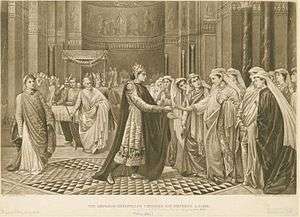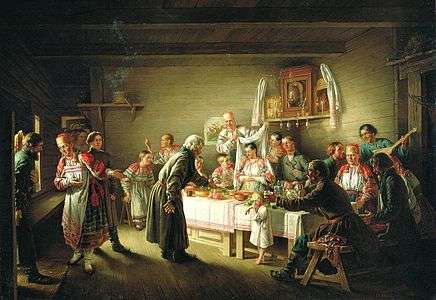Bride-show
The bride-show was a custom of Byzantine emperors and Russian tsars to choose a wife from among the most beautiful maidens of the country. A similar practice was also existent in Imperial China.

.jpg)
Byzantium
The method to select a bride for the emperor through the method of Bride-show is known to have been used at least from the 8th century onward. Irene of Athens was likely chosen for Leo IV the Khazar by this method, though it has not been confirmed.
The first recorded bridal show in Byzantine was however the one in 788, in which Maria of Amnia was selected for emperor Constantine. The method was regularly used in the 8th and 9th centuries. Among notable bride-shows was the one in which Theodora was selected by Theophilos and Kassia rejected.
None of the empresses of the 10th century onward, however, are confirmed to have been selected this way, and the custom was surely dead by the 13th century.
Imperial China
Imperial China practiced a similar method in which to choose wives for the emperor at least from the Song dynasty (960-1279) onward; in this case not just one empress, but also the various consorts and concubines of lower ranks for the emperor. During the Qing dynasty (1644-1912), daughters of the elite families were summoned to the imperial palace prior to marriage for inspection, and selected by the emperor to become his empress, secondary imperial consorts or concubines before the rest of them were released and allowed to marry.[1]

Muscovite Russia
The Byzantine method was transferred to Muscovite Russia, where it became the traditional method to select a bride from the boyar nobility for the Tsar in the contemporary Russian culture, where the Terem otherwise secluded women of the aristocracy from men.
The method was regularly used in the 16th- and 17th-century. This was the case with the three wives of Ivan IV of Russia. The first time this method was securely recorded was in 1505, when Solomoniya Saburova was selected for Vasily III of Moscow this way. The method was introduced by Vasily's Byzantine mother, Sophia Paleologue.
The last time a bride-show was held to arrange a marriage to a Russian Tsar was that of Ivan V of Russia to Praskovia Saltykova in 1684. After this, Russia was Westernized in accordance with the reforms of Peter the Great and this method was abandoned.
See also
References
Further reading
| Wikimedia Commons has media related to The Bride-show. |
- Afinogenov, D. "The Bride-show of Theophilos: Some notes on the Sources", Eranos 95. 1997, pp. 10–18.
- Rydén, Lennart. "The Bride-shows at the Byzantine Court - History or Fiction?" Eranos 83, 1985, pp. 175–191.
- Treadgold, W. T., "The Bride-shows of the Byzantine Emperors", Byzantion 49. 1979, pp. 395–413.
- Bourboulis, Photeine, “The Bride-Show Custom and the Fairy-Story of Cinderella.” In P. P. Bourboulis, Studies in the History of Modern Greek Story-Motives. Thessalonike, 1953. Pp. 40–52.